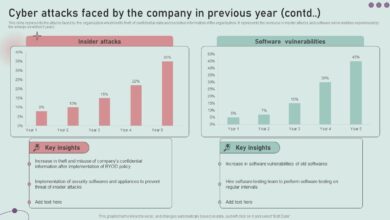
Exploring Cybersecurity Research Topics for Masters Studies
Exploring cybersecurity research topics for masters degree studies is more than just picking a subject; it’s about diving headfirst into a field brimming with critical challenges and exciting possibilities. From the ever-evolving landscape of network security and the vulnerabilities of increasingly sophisticated applications, to the complex world of cryptography and the ethical dilemmas inherent in this powerful technology, the options are vast and deeply impactful.
This journey promises to uncover cutting-edge research areas, pushing the boundaries of what’s possible in protecting our digital world. We’ll explore the practical applications of AI and blockchain, the challenges posed by the IoT and quantum computing, and the critical need for robust cybersecurity management and policy. Get ready to delve into a field that’s as dynamic as it is crucial.
This post aims to provide a structured overview of potential research avenues, offering a glimpse into the key areas, methodologies, and emerging trends shaping the future of cybersecurity. We’ll touch upon network security challenges, application vulnerabilities, the power of cryptography, the crucial role of policy and management, and the exciting implications of AI, IoT, and quantum computing. Each area offers a rich tapestry of potential research projects, allowing you to tailor your studies to your specific interests and passions within this ever-evolving field.
Introduction to Cybersecurity Research

Cybersecurity research is a dynamic and ever-evolving field, crucial for safeguarding our increasingly interconnected world. The digital landscape is constantly shifting, presenting new challenges and opportunities for researchers to explore and innovate. This introduction will delve into the current threat landscape, the methodologies employed in cybersecurity research, and the ethical considerations that guide this vital work.
The Current Landscape of Cybersecurity Threats and Vulnerabilities
The current cybersecurity threat landscape is characterized by a sophisticated and persistent range of attacks targeting individuals, organizations, and nations. Advanced Persistent Threats (APTs), often state-sponsored, employ highly targeted and stealthy techniques to infiltrate systems and steal sensitive information. Ransomware attacks continue to plague businesses, crippling operations and demanding significant ransoms for data recovery. Furthermore, the increasing reliance on cloud services and the Internet of Things (IoT) expands the attack surface, creating more vulnerabilities that malicious actors can exploit.
Phishing and social engineering remain prevalent, exploiting human weaknesses to gain unauthorized access. The sheer volume and variety of attacks, coupled with the rapid evolution of attack methods, necessitate ongoing and robust cybersecurity research.
Evolution of Cybersecurity Research Methodologies
Cybersecurity research methodologies have evolved significantly, mirroring the advancements in technology and the sophistication of cyberattacks. Early research focused primarily on network security and cryptography. The emergence of the internet and widespread computer usage led to a focus on software security and vulnerability analysis. Today, research incorporates a multidisciplinary approach, drawing upon fields such as artificial intelligence, machine learning, and data science to detect and mitigate threats.
Formal methods, which use mathematical techniques to verify the security of systems, are becoming increasingly important. Furthermore, the rise of crowdsourced security research and bug bounty programs has significantly broadened the scope of vulnerability discovery and remediation. This collaborative approach has proven effective in identifying previously unknown weaknesses in widely used software and hardware.
Ethical Considerations in Cybersecurity Research
Ethical considerations are paramount in cybersecurity research. Researchers must adhere to strict guidelines to ensure that their work does not inadvertently contribute to malicious activities. Responsible disclosure of vulnerabilities is crucial; researchers should responsibly report vulnerabilities to vendors before publicly disclosing them, allowing time for remediation. The potential for misuse of research findings must be carefully considered.
For instance, research on new attack techniques should be conducted responsibly, with appropriate safeguards to prevent malicious actors from exploiting the findings. Furthermore, privacy concerns must be addressed, ensuring that research activities do not compromise the privacy of individuals or organizations. Researchers should obtain appropriate consent and anonymize data where necessary. The development and deployment of AI-powered security tools also raise ethical questions regarding bias, fairness, and accountability.
These ethical considerations must be at the forefront of every cybersecurity research endeavor.
Network Security Research Areas
Network security is a constantly evolving field, driven by the increasing complexity of our interconnected world. Research in this area is crucial for developing robust defenses against ever-more sophisticated cyber threats. This section delves into some key areas within network security research, focusing on Software Defined Networks (SDNs), intrusion detection and prevention systems, and the design of secure cloud-based infrastructures.
Securing Software Defined Networks (SDNs)
Software Defined Networks offer significant advantages in terms of flexibility and manageability, but they also introduce new security challenges. The centralized control plane, while beneficial for management, becomes a single point of failure and a tempting target for attackers. Research in SDN security focuses on mitigating these risks through techniques like secure control plane protocols, robust authentication and authorization mechanisms, and advanced anomaly detection systems tailored to the SDN architecture.
Opportunities lie in developing novel security solutions that leverage the programmability of SDNs to dynamically adapt to evolving threats, creating self-healing and resilient networks. For example, research into integrating AI and machine learning into SDN controllers could enable proactive threat mitigation and automated incident response.
Intrusion Detection and Prevention Systems (IDPS)
Intrusion Detection and Prevention Systems represent a cornerstone of network security. They vary significantly in their approaches, broadly categorized as signature-based, anomaly-based, and hybrid systems. Signature-based systems rely on known attack patterns (signatures) to detect malicious activity, offering high accuracy for known threats but struggling with novel attacks. Anomaly-based systems, conversely, learn normal network behavior and flag deviations as potential intrusions.
They are better at detecting zero-day attacks but can generate false positives. Hybrid systems combine both approaches, aiming to leverage the strengths of each. The ongoing challenge lies in improving the accuracy and efficiency of these systems, particularly in reducing false positives in anomaly-based systems and expanding the coverage of signature-based systems to encompass the constantly evolving threat landscape.
Research focuses on developing more sophisticated algorithms, leveraging machine learning and artificial intelligence to improve detection rates and reduce the reliance on human intervention.
Secure Architecture for a Cloud-Based Infrastructure
Designing a secure cloud-based infrastructure requires a multi-layered approach encompassing physical, network, and application security. Key considerations include data encryption at rest and in transit, robust access control mechanisms, and regular security audits. Furthermore, incorporating principles of zero trust security, which assumes no implicit trust, is crucial. This involves verifying every access request regardless of its origin, thus limiting the impact of compromised credentials.
| Solution | Strengths | Weaknesses | Cost |
|---|---|---|---|
| Virtual Private Cloud (VPC) | Isolation, enhanced security, scalability | Can be complex to configure and manage, requires expertise | Varies greatly depending on provider and usage |
| Cloud Access Security Broker (CASB) | Centralized security policy enforcement, data loss prevention | Can introduce latency, requires integration with existing infrastructure | Subscription-based, cost varies depending on features and usage |
| Data Loss Prevention (DLP) tools | Prevent sensitive data from leaving the cloud environment | Can generate false positives, requires careful configuration | Varies depending on features and deployment model |
| Multi-Factor Authentication (MFA) | Stronger authentication, reduces risk of unauthorized access | Can be inconvenient for users, requires user education | Generally low cost, often included in cloud provider packages |
Application Security Research
Application security is a critical area of cybersecurity research, focusing on protecting software applications from vulnerabilities and attacks. This field encompasses a wide range of topics, from securing mobile apps to fortifying web applications and implementing secure software development practices. Understanding and mitigating these vulnerabilities is crucial for protecting sensitive data and maintaining user trust.
Mobile Application Vulnerabilities and Mitigation Strategies
Mobile applications, due to their inherent nature and access to diverse device functionalities, present unique security challenges. These vulnerabilities often stem from insecure coding practices, inadequate data protection, and insufficient platform-specific security considerations. For example, improper handling of user authentication credentials can lead to unauthorized access, while insecure data storage can expose sensitive information to attackers.
- Insecure Data Storage: Storing sensitive data like passwords or personal information in plain text within the application’s database or local storage is a significant vulnerability. Mitigation involves employing strong encryption techniques and adhering to best practices for data protection.
- Lack of Input Validation: Failure to properly validate user inputs can lead to injection attacks (SQL injection, command injection). Implementing robust input validation and sanitization routines is essential to prevent these attacks.
- Improper Authentication and Authorization: Weak or easily guessable passwords, coupled with inadequate authorization mechanisms, can allow unauthorized access to application features and data. Strong authentication protocols (e.g., multi-factor authentication) and role-based access control are crucial.
- Unpatched Software Libraries: Using outdated or unpatched third-party libraries exposes the application to known vulnerabilities. Regularly updating these libraries and using secure coding practices minimizes the risk.
Common Web Application Vulnerabilities and Prevention
Web applications are constantly targeted by attackers seeking to exploit vulnerabilities for data breaches, denial-of-service attacks, or other malicious purposes. Understanding these common vulnerabilities and implementing preventative measures is vital for maintaining the security and integrity of web applications.
- Cross-Site Scripting (XSS): XSS attacks allow attackers to inject malicious scripts into web pages viewed by other users. Preventing XSS involves proper input validation, output encoding, and using a web application firewall (WAF).
- SQL Injection: SQL injection attacks allow attackers to manipulate database queries to gain unauthorized access to data. Parameterized queries and input validation are effective preventative measures.
- Cross-Site Request Forgery (CSRF): CSRF attacks trick users into performing unwanted actions on a web application. Implementing CSRF tokens and verifying HTTP referrers can prevent these attacks.
- Session Management Issues: Insecure session management practices can lead to session hijacking. Using secure session IDs, short session timeouts, and HTTPS are important preventative measures.
Secure Software Development Lifecycle (SDLC) Implementation
A secure SDLC integrates security considerations into every phase of software development, from requirements gathering to deployment and maintenance. This approach helps to identify and mitigate vulnerabilities early in the development process, reducing the overall risk and cost associated with security breaches.
Implementing a secure SDLC involves several key practices: Security requirements should be defined early in the project lifecycle, security testing should be conducted throughout the development process (including penetration testing and code reviews), and a vulnerability management program should be in place to address identified vulnerabilities promptly. Furthermore, developers should receive training on secure coding practices, and automated security tools should be integrated into the development pipeline.
Cryptography and Data Security Research
Cryptography and data security are cornerstones of modern cybersecurity, constantly evolving to meet increasingly sophisticated threats. This section explores various encryption algorithms, the application of blockchain technology for enhanced data protection, and the challenges posed by the exponential growth of data in the cloud.
Comparison of Encryption Algorithms, Exploring cybersecurity research topics for masters degree studies
Different encryption algorithms offer varying levels of security and performance. The choice of algorithm depends heavily on the specific application and the sensitivity of the data being protected. Symmetric encryption, like AES (Advanced Encryption Standard), uses the same key for both encryption and decryption, offering faster processing speeds but requiring secure key exchange. Asymmetric encryption, such as RSA (Rivest–Shamir–Adleman), uses separate public and private keys, simplifying key distribution but generally being slower.
Elliptic curve cryptography (ECC) provides strong security with smaller key sizes compared to RSA, making it suitable for resource-constrained environments.
- AES (Symmetric): Strengths: High security, fast processing. Weaknesses: Requires secure key exchange.
- RSA (Asymmetric): Strengths: Secure key distribution. Weaknesses: Slower processing speeds, computationally expensive for large keys.
- ECC (Elliptic Curve): Strengths: Strong security with smaller key sizes. Weaknesses: Can be vulnerable to certain side-channel attacks if not implemented carefully.
Blockchain Technology for Enhanced Data Security
Blockchain technology, renowned for its use in cryptocurrencies, offers several advantages for enhancing data security. Its decentralized, immutable ledger provides a transparent and auditable record of data transactions, making it difficult to alter or delete information retrospectively. This feature is particularly valuable in securing sensitive data like medical records or financial transactions. The use of cryptographic hashing and digital signatures further enhances the integrity and authenticity of the data stored on the blockchain.
So, I’m diving deep into cybersecurity research topics for my master’s, and cloud security is a huge area. One fascinating aspect I’m exploring is the evolution of Cloud Security Posture Management (CSPM), especially as highlighted in this insightful article on bitglass and the rise of cloud security posture management. Understanding Bitglass’s role in this space is crucial for my research, as it directly impacts the future of securing cloud environments.
Ultimately, this informs my broader investigation into effective cybersecurity strategies for the modern enterprise.
For example, a healthcare provider could use a blockchain to securely store patient medical records, allowing authorized personnel to access the information while maintaining a verifiable audit trail. Each update or access is recorded on the blockchain, creating a tamper-evident history.
Challenges of Securing Data in the Era of Big Data and Cloud Computing
The exponential growth of data and its increasing reliance on cloud storage present significant challenges to data security. The sheer volume of data makes traditional security methods less efficient, while the distributed nature of cloud environments increases the attack surface. Data breaches in cloud storage, like the one experienced by Capital One in 2019, highlight the vulnerability of centralized repositories.
Other significant challenges include: data governance and compliance with regulations like GDPR; securing data in transit and at rest; and managing the risks associated with third-party vendors who manage cloud infrastructure. The need for robust data loss prevention (DLP) measures and advanced threat detection systems is paramount. Furthermore, the increasing sophistication of cyberattacks, including AI-powered attacks, demands a proactive and adaptive approach to data security.
Cybersecurity Management and Policy
Effective cybersecurity management and policy are crucial for protecting organizations from the ever-evolving threat landscape. A robust framework encompasses incident response planning, comprehensive awareness training, and adherence to relevant regulations. These elements work synergistically to minimize vulnerabilities and mitigate the impact of security breaches.
Cybersecurity Incident Response Plan for a Hypothetical Organization
This section details a hypothetical incident response plan for “Acme Corp,” a mid-sized software company. The plan Artikels procedures for detecting, responding to, and recovering from various cybersecurity incidents. The plan emphasizes speed, containment, and minimizing damage. The phases include Preparation, Identification, Containment, Eradication, Recovery, and Lessons Learned. Acme Corp’s plan includes pre-defined roles and responsibilities for each team member involved in the incident response process, ensuring a coordinated and effective response.
Regular testing and updates of the plan are critical to maintain its effectiveness. For example, a simulated phishing attack could test the effectiveness of employee awareness training and incident response procedures. A post-incident review would identify areas for improvement.
Cybersecurity Awareness Training and its Impact on Organizational Security
Cybersecurity awareness training significantly enhances an organization’s security posture. Employees are often the weakest link in the security chain, and targeted attacks frequently exploit human error. Effective training programs educate employees about various threats, such as phishing emails, malware, and social engineering tactics. This empowers employees to identify and report suspicious activities promptly, minimizing the risk of successful attacks.
For instance, a program might include interactive modules, simulated phishing exercises, and regular updates on current threats. Measuring the effectiveness of the training can be achieved through assessments and tracking the number of reported security incidents. A reduction in reported phishing attempts, for example, would indicate successful training.
The Role of Government Regulations and Policies in Shaping Cybersecurity Practices
Government regulations and policies play a vital role in establishing minimum security standards and promoting responsible cybersecurity practices across industries. These regulations often mandate specific security controls, data protection measures, and incident reporting requirements. Compliance with these regulations is crucial for organizations to avoid penalties and maintain public trust. The impact of these regulations extends beyond compliance, fostering a culture of security and driving innovation in cybersecurity technologies and practices.
Failure to comply can result in significant financial penalties and reputational damage.
Key Cybersecurity Regulations
The following is a list of key cybersecurity regulations influencing organizational practices:
- General Data Protection Regulation (GDPR): Regulates the processing of personal data within the European Union and the European Economic Area.
- California Consumer Privacy Act (CCPA): Grants California residents specific rights regarding their personal data.
- Health Insurance Portability and Accountability Act (HIPAA): Protects the privacy and security of patients’ health information in the United States.
- Payment Card Industry Data Security Standard (PCI DSS): Sets standards for protecting credit card information.
- National Institute of Standards and Technology (NIST) Cybersecurity Framework: Provides a voluntary framework for improving cybersecurity practices.
Emerging Trends in Cybersecurity Research: Exploring Cybersecurity Research Topics For Masters Degree Studies
The field of cybersecurity is in constant evolution, driven by technological advancements and the ever-increasing sophistication of cyber threats. Understanding emerging trends is crucial for researchers to anticipate future challenges and develop innovative solutions. This section will explore three key areas: the impact of Artificial Intelligence (AI), the challenges of the Internet of Things (IoT), and the revolutionary potential of quantum computing.
Artificial Intelligence in Cybersecurity
AI is rapidly transforming cybersecurity, offering both defensive and offensive capabilities. On the defensive side, AI algorithms can analyze vast amounts of data to detect anomalies and predict potential threats in real-time, far exceeding human capabilities in speed and scale. Machine learning models, for instance, can be trained to identify malicious patterns in network traffic, email content, and system logs, enabling proactive threat mitigation.
Conversely, AI also presents offensive risks. Sophisticated AI-powered malware can adapt and evade traditional security measures, leading to more resilient and difficult-to-detect attacks. The development of AI-powered phishing campaigns, capable of crafting highly personalized and convincing messages, represents a significant threat. The arms race between AI-powered defense and AI-powered offense is a defining characteristic of modern cybersecurity research.
Internet of Things (IoT) Security Challenges
The proliferation of IoT devices presents unprecedented cybersecurity challenges. The sheer number of interconnected devices, coupled with their often-limited processing power and security features, creates a vast attack surface. Many IoT devices lack robust authentication mechanisms and encryption protocols, making them vulnerable to various attacks, including data breaches, denial-of-service attacks, and device hijacking. The lack of standardized security protocols across different IoT ecosystems further exacerbates the problem.
For example, a compromised smart home device could provide entry points for attacks on other connected devices, potentially compromising sensitive personal information or critical infrastructure. Research in this area focuses on developing lightweight security protocols suitable for resource-constrained IoT devices, improving device authentication and secure data transmission, and establishing robust security frameworks for managing large-scale IoT deployments.
Quantum Computing’s Impact on Cryptography
Quantum computing, while still in its nascent stages, poses a significant threat to current cryptographic systems. Quantum computers, with their ability to perform computations beyond the reach of classical computers, could potentially break widely used encryption algorithms like RSA and ECC, which underpin much of modern online security. This would have catastrophic consequences for online transactions, data privacy, and national security.
However, the threat also drives innovation. Post-quantum cryptography (PQC) is an active area of research, focusing on developing cryptographic algorithms resistant to attacks from quantum computers. Researchers are exploring various approaches, including lattice-based cryptography, code-based cryptography, and multivariate cryptography. The transition to PQC will require significant effort in algorithm standardization, implementation, and deployment, presenting both challenges and opportunities for cybersecurity researchers.
Visualizing Cybersecurity Research Findings
Data visualization is crucial in cybersecurity research. Effectively communicating complex findings requires clear, concise visuals that translate technical details into readily understandable insights. This allows researchers to not only share their work more effectively but also identify patterns and trends that might otherwise be missed. Visualizations can range from simple charts illustrating attack frequency to intricate network graphs depicting data flow and vulnerabilities.
Cyberattack Lifecycle Visualization
A typical cyberattack follows a distinct lifecycle. Visualizing this lifecycle helps researchers understand attack methodologies and develop effective countermeasures. Imagine a circular diagram, divided into several segments representing each stage. The first segment, Reconnaissance, depicts the attacker gathering information about the target. This could be represented by an icon of a magnifying glass over a computer.
The next segment, Weaponization, shows the attacker developing or acquiring malicious tools. This might be visualized as a syringe injecting code into a computer. The third segment, Delivery, illustrates how the attacker delivers the weapon, perhaps through a phishing email (depicted as an envelope with a warning sign). Exploitation represents the successful compromise of a system (shown as a cracked lock icon).
Installation, the next stage, shows the attacker establishing persistent access (a small green plant sprouting from the compromised system). Command and Control depicts the attacker’s communication with the compromised system (a satellite dish). Actions on Objectives illustrate the attacker’s goals, such as data exfiltration (data flowing out of the system). Finally, the last segment, Exfiltration, shows the attacker removing stolen data (a hard drive leaving the system).
Each segment should include annotations describing potential mitigation strategies, such as strong passwords, intrusion detection systems, and regular security audits.
So, I’m deep diving into cybersecurity research topics for my master’s, trying to find that sweet spot between practical application and theoretical depth. One area that immediately jumped out was the security implications of rapid application development, especially considering the rise of low-code/no-code platforms. This led me to check out a great article on domino app dev the low code and pro code future , which really highlighted the potential vulnerabilities inherent in such streamlined development processes.
Understanding these vulnerabilities is crucial for my research into securing future applications.
Visualizing Relationships Between Cybersecurity Domains
Understanding the interconnectedness of different cybersecurity domains is critical for a holistic approach to security. The following visual representation uses overlapping circles to illustrate the relationships.
Network Security, Application Security, and Cryptography are interconnected. Network security focuses on protecting the network infrastructure, while application security deals with securing individual applications. Cryptography underpins both, providing the essential algorithms for secure communication and data protection.
Effective cybersecurity requires a holistic approach, integrating all three domains. Weaknesses in one area can compromise the overall security posture.
For instance, a vulnerability in an application (Application Security) can expose the network (Network Security) to attack, unless strong cryptographic techniques (Cryptography) are implemented to protect sensitive data.
Closing Summary

Choosing a cybersecurity research topic for your master’s degree is a significant step, and hopefully this exploration has illuminated the diverse and fascinating possibilities. Remember, the field is constantly evolving, so staying curious, keeping abreast of the latest threats and advancements, and identifying areas where your unique skills and perspectives can make a contribution are crucial. Whether you’re drawn to the intricate world of cryptography, the challenges of securing cloud infrastructures, or the ethical implications of AI in cybersecurity, your research has the potential to significantly impact the digital landscape.
So, embark on your journey with passion, rigor, and a commitment to securing a safer digital future.
FAQ Explained
What are the typical time commitments for a cybersecurity masters research project?
Time commitments vary significantly depending on the scope and complexity of the project, but typically involve several months of dedicated research, writing, and analysis.
How do I find a suitable research advisor or supervisor?
Connect with professors whose research interests align with yours. Review faculty profiles and publications, and reach out to those whose work excites you.
What types of data sources are commonly used in cybersecurity research?
Common sources include publicly available datasets, simulated network environments, vulnerability databases, and, with ethical approvals, real-world network traffic data.
What are some common challenges faced during cybersecurity research?
Challenges include accessing relevant data, dealing with ethical considerations, managing the complexity of systems, and staying up-to-date with rapidly evolving technologies.





